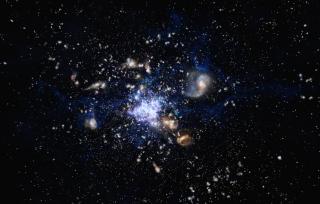Bibcode
D'Eugenio, C.; Daddi, E.; Gobat, R.; Strazzullo, V.; Lustig, P.; Delvecchio, I.; Jin, S.; Puglisi, A.; Calabró, A.; Mancini, C.; Dickinson, M.; Cimatti, A.; Onodera, M.
Referencia bibliográfica
The Astrophysical Journal
Fecha de publicación:
3
2020
Revista
Número de citas
53
Número de citas referidas
48
Descripción
We have obtained spectroscopic confirmation with Hubble Space Telescope WFC3/G141 of a first sizeable sample of nine quiescent galaxies at 2.4 < z < 3.3. Their average near-UV/optical rest-frame spectrum is characterized by low attenuation (AV ∼ 0.6 mag) and a strong Balmer break, larger than the 4000 Å break, corresponding to a fairly young age of ∼300 Myr. This formally classifies a substantial fraction of classically selected quiescent galaxies at z ∼ 3 as post-starbursts, marking their convergence to the quenching epoch. The rapid spectral evolution with respect to z ∼ 1.5 quiescent galaxies is not matched by an increase of residual star formation, as judged from the weak detection of [O ii]λ3727 emission, pointing to a flattening of the steep increase in gas fractions previously seen from z ∼ 0 to 1.8. However, radio 3 GHz stacked emission implies either much stronger dust-obscured star formation or substantial further evolution in radio-mode AGN activity with respect to z ∼ 1.5.
Proyectos relacionados

Gas Molecular y Polvo en Galacias através del Tiempo Cósmico
Dos cuestiones fundamentales en la Astrofísica son la conversión de gas molecuar en estrellas y cómo este proceso físico depende del entorno en todas las escalas, desde sistemas planetarios, cúmulos estelares, galaxias hasta cúmulos de galaxias. El objectivo principal de este proyecto es el de estudiar la formación y evolución de galaxias a partir
Helmut
Dannerbauer